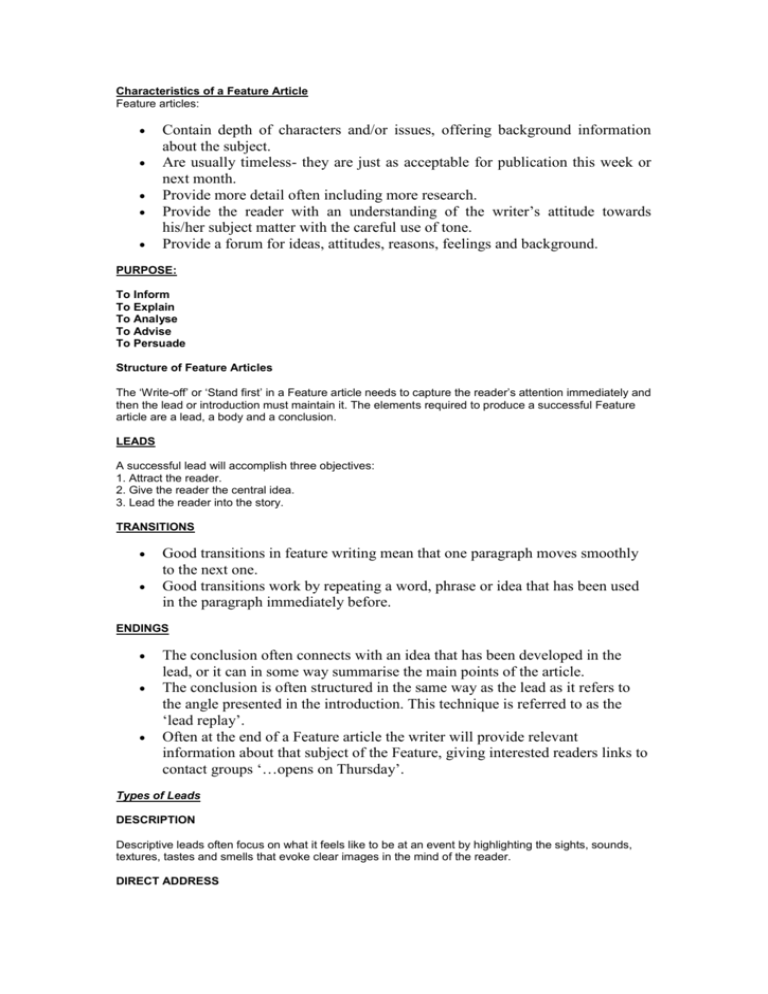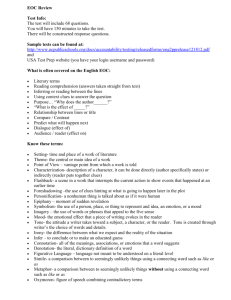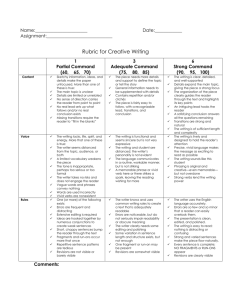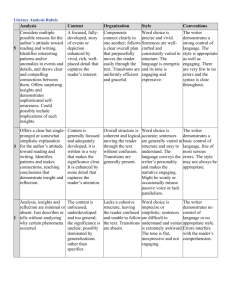Characteristics of a Feature Article
advertisement

Characteristics of a Feature Article Feature articles: Contain depth of characters and/or issues, offering background information about the subject. Are usually timeless- they are just as acceptable for publication this week or next month. Provide more detail often including more research. Provide the reader with an understanding of the writer’s attitude towards his/her subject matter with the careful use of tone. Provide a forum for ideas, attitudes, reasons, feelings and background. PURPOSE: To Inform To Explain To Analyse To Advise To Persuade Structure of Feature Articles The ‘Write-off’ or ‘Stand first’ in a Feature article needs to capture the reader’s attention immediately and then the lead or introduction must maintain it. The elements required to produce a successful Feature article are a lead, a body and a conclusion. LEADS A successful lead will accomplish three objectives: 1. Attract the reader. 2. Give the reader the central idea. 3. Lead the reader into the story. TRANSITIONS Good transitions in feature writing mean that one paragraph moves smoothly to the next one. Good transitions work by repeating a word, phrase or idea that has been used in the paragraph immediately before. ENDINGS The conclusion often connects with an idea that has been developed in the lead, or it can in some way summarise the main points of the article. The conclusion is often structured in the same way as the lead as it refers to the angle presented in the introduction. This technique is referred to as the ‘lead replay’. Often at the end of a Feature article the writer will provide relevant information about that subject of the Feature, giving interested readers links to contact groups ‘…opens on Thursday’. Types of Leads DESCRIPTION Descriptive leads often focus on what it feels like to be at an event by highlighting the sights, sounds, textures, tastes and smells that evoke clear images in the mind of the reader. DIRECT ADDRESS This is when the writer tries to engage the reader immediately. This can be done by asking questions or asking the reader to imagine something in particular. It is as though the writer is expecting some direct responses from the reader. SHOCKING STATEMENT This type of lead is also known as “the teaser”. A shocking or striking statement is one that will produce a strong response in the reader. Often it will challenge some accepted belief, or simply be provocative. Statistics are often effective. It involves the reader by building suspense before revealing the focus of the story. NARRATIVE The narrative lead tells a story. Sometimes a short piece, often from the writer’s own experience, will lead the reader into the article. Though it is also descriptive, the narrative lead is more like a play with a scene characters and dialogue. QUOTATION A relevant and effective quotation can introduce the reader to the theme of the article. The quote should compel the reader to go further into the story. QUESTION Should be used only when the question relates directly to the Feature angle and compels the reader to seek the answers further in the story. Unfortunately, most question leads can be answered with another question. LANGUAGE AND GRAMMATICAL CHARACTERISTICS OF FEATURE ARTICLES PARAGRAPHING Paragraphs of one to four sentences are used in newspaper feature articles. QUOTATIONS Inverted commas indicate direct quotations. Quotes from eyewitnesses, sources or experts are included in the text. REGISTERED Individual speakers who are quoted in a Feature article often use emotive language. Feature articles are more creative in the use of language than a news report, often using emotive language. Feature articles contain objective material but often appeal to emotions. KEY WORDS The vocabulary includes many words that relate to the specific subject discussed. An extensive written vocabulary is used. Contractions are often used to create a “chatty/informal” person-to-person tone. SUBJECT MATTER OF FEATURE ARTICLES Feature Articles are usually longer than News Reports and Columns and are written about a range of topics including: Society Health Food Politics Entertainment Individuals The Environment Sport Economics Current Issues LAYOUT OF FEATURE ARTICLES Each Feature article has a headline. Feature articles generally include a synopsis as part of the byline. The synopsis provides the reader with information about the content of the text. It is known as a ‘Write of’ of ‘Stand first’. Feature articles include a byline. The byline states the name of the writer. This is often part of the ‘Write off/ Stand first’ A photograph, graphics, illustration or cartoon usually accompanies feature articles. The text is written in column format. A BreakOut Box may support feature articles. A BreakOut Box appears next to the news report and provides readers with related factual information about the topic. Information in the BreakOut Box includes the use of technical terms, explanations, graphics and statistics. Several types and sizes of fonts are used. Colour is often used in either the headline and/or photograph(s). Feature articles are usually much longer than news reports and may or may not be linked to a current “hard news” event.







